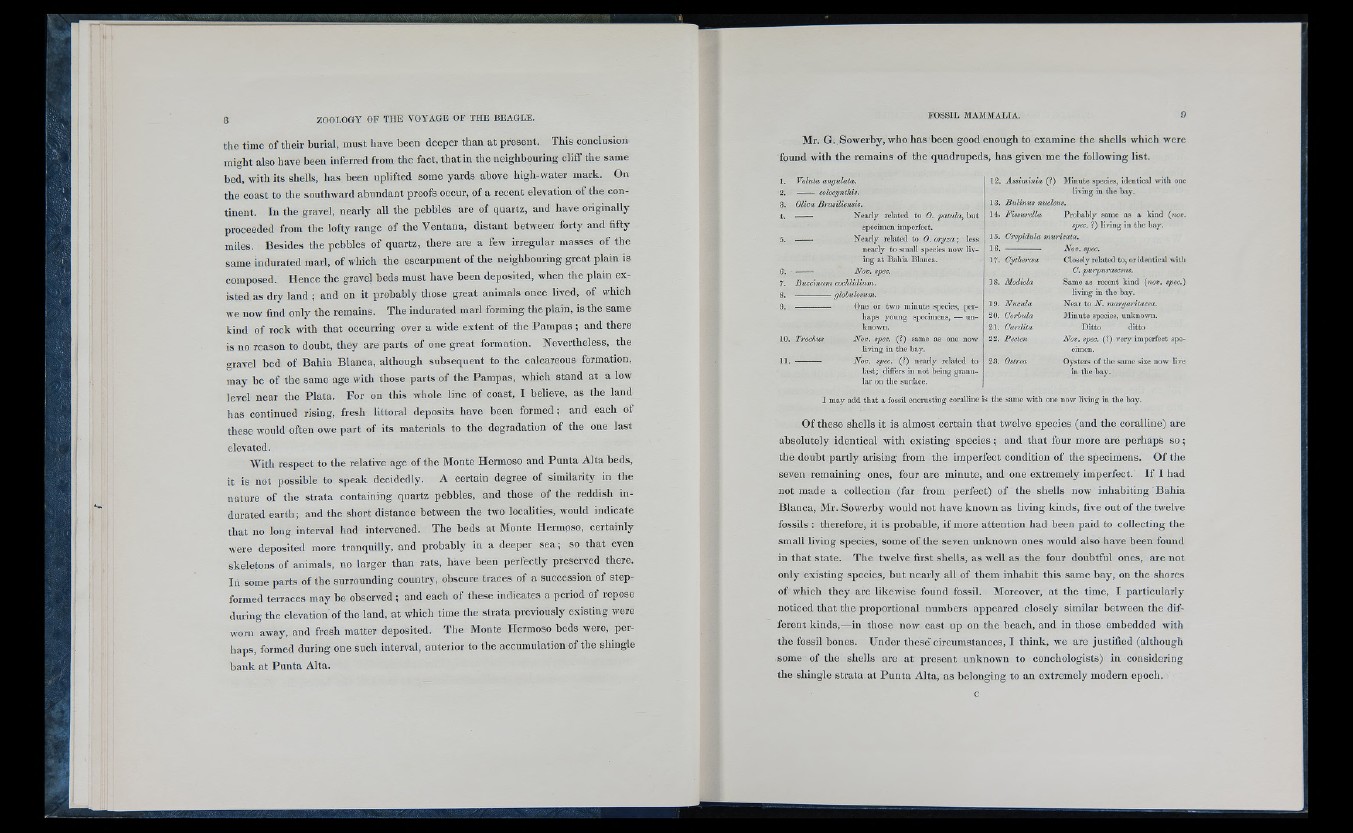
the time o f their burial, must have been deeper than at present. This conclusion
might also have been inferred from the fact, tliat in the neighbouring cliff the same
bed, with its shells, has been uplifted some yards above high-water mark. On
the coast to the southward abundant proofs occur, of a recent elevation o f the continent.
In the gravel, nearly all the pebbles are of quartz, and have originally
proceeded from the lofty range o f the Ventana, distant between forty and fifty
miles. B esid es the pebbles o f quartz, there are a few irregular masses o f the
same indurated marl, o f which the escarpment o f the neighbouring great plain is
composed. Hence the gravel beds must have been deposited, when the plain ex isted
as dry land ; and on it probably those great animals once lived, of which
we now find only the remains. The indurated marl forming the plain, is the same
kind o f rock with that occurring over a wide extent o f the Pampas ; and there
is no reason to doubt, they are parts o f one great formation. Nevertlieless, the
gravel bed o f Bahia Blanca, although subsequent to the calcareous formation,
may be o f the same age with those parts o f the Pampas, which stand at a low
lev el near the Pla ta . For on this whole line o f coast, I believe, as the land
has continued rising, fresh littoral deposits have been formed ; and each of
these would often owe part o f its materials to the degradation o f the one last
elevated.
With respect to the relative age of the Monte Hermoso and Punta Alta beds,
it is not possible to speak decidedly. A certain degree o f similarity in the
nature o f the strata containing quartz pebbles, and those o f the reddish in durated
earth; and the short distance between the two localities, would indicate
that no long interval had intervened. The beds at Monte Hermoso, certainly
were deposited more tranquilly, and probably in a deeper se a ; so that even
skeletons o f animals, no larger than rats, have been perfectly preserved there.
In some parts o f the surrounding country, obscure traces o f a succession o f step-
formed terraces may be observed ; and each o f these indicates a period o f repose
during the elevation o f the land, at which time the strata previously ex isting were
worn away, and fresh matter deposited. The Monte Hermoso beds were, perhaps,
formed during one such interval, anterior to the accumulation o f the shingle
hank at Punta Alta.
Mr. G. Sowerby, who has been good enough to examine the she lls which were
found with the remains o f the quadrupeds, has given me the following list.
1 . Voluta angulata. 12. Assiminia (I) Minute species, identical with one
2. colocynthis. living in the bay.
3. Oliva ßrasiliensis.
13. Bulinus
4. ------ Nearly related to 0. patula, but
14. Fismrella Probably same as a kind {nov.
spec. ?) living in the bay.
15. Crepidula muricata.
16. ------------- Nov. spec.
17. Cythercea Closely related to, oridentical with
C. purpurascens.
IS. Modiola Same as recent kind {nov. spec.)
living in the bay.
19. Nucula Heux to N . maryarilacea.
20. Corhula Minute speeies, unknown.
21. Cardita Ditto ditto
22. Pecten Nov. spec. (?) very imperfect specimen.
23. Ostrea Oysters of the same size now live
in tlie bay.
specimen imperfect.
5. ------ Nearly related to 0. o r y za ; less
nearly to small species now living
at Bahia Blanca.
6. • ------ Nov. spec.
7. Buccinum cochlidium.
8. globulosum.
9. ------------- One or two minute species, perhaps
young specimens, — unknown.
10. Trochus Nov. spec. (?) same as one now
living in the bay.
11. --------- Nov. spec. (?) nearly related to
last; differs in not being granular
on the surface.
I may add that a fossil encrusting coralline is the same with one now living in the bay.
O f these she lls it is almost certain that twelve spe cie s (and the coralline) are
absolutely identical with ex isting sp e c ie s; and that four more are perhaps so;
the doubt partly arising from the imperfect condition o f the specimens. O f the
seven remaining ones, four are minute, and one extremely imperfect. I f I had
not made a collection (far from perfect) o f the she lls now inhabiting Bahia
Blanca, Mr. Sowerby would not have known as living kinds, five out o f the twelve
fossils : therefore, it is probable, if more attention had been paid to collecting the
small living species, some o f the seven unknown ones would also have been found
in that state. The twelve first shells, as well as the four doubtful ones, are not
only ex isting species, but nearly all o f them inhabit this same bay, on the shores
of which they are likewise found fossil. Moreover, at the time, I particularly
noticed that the proportional numbers appeared c lose ly similar between the different
kinds,—in those now cast up on the beach, and in those embedded with
the fossil bones. Under these"circumstances, I think, we are justified (although
some o f the shells are at present unknown to conchologists) in considering
the shingle strata at l^unta Alta, as belonging to an extremely modern epoch.